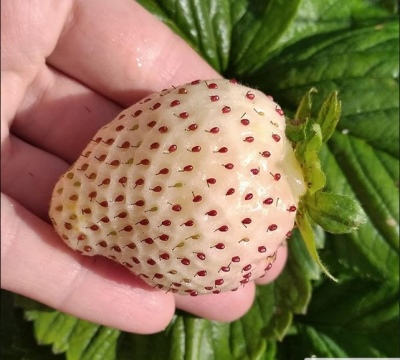
- Name synonyms: White
- Taste: sweet and sour, pineapple
- The size: large
- Weight: 20-23 gr
- Yield: 0.4-0.65 kg per bush
- Ripening terms: medium
- Advantages: unattractiveness to the invasion of birds due to its pale color, the ability to eat berries even for allergy sufferers due to the lack of red pigment, tolerates winter temperature fluctuations and thaws well
- Appointment: fresh consumption
- Description of the bush: compact, squat
- Berry color: White
Strawberry White Swede (synonym - White) was bred in Sweden and is the largest of the modern varieties of white strawberries. Gardeners acquire it rather for the sake of curiosity and interest to grow strawberries with berries of an unusual color on their plots. But this variety has many advantages, including excellent taste and aroma, good yield and winter hardiness.
Description of the variety
The strawberry variety White Shved is characterized by compact, squat bushes up to 20 cm tall. The leaves are small, vertically directed, slightly pubescent and have a dark green color. One plant has up to 10 strong peduncles. The variety blooms profusely with white beautiful flowers. The mustache of the White Swede is formed, but in small quantities.
Ripening terms
This variety is characterized by average fruiting times. The main ripening period for berries is in June. They do not lose their shape from sunlight. Ripeness can be determined by the seeds that turn dark red. To give the fruit more sugar content, it is recommended to spray the bushes early in the morning or in the evening with special solutions containing potassium.
Yield
On average, 0.4-0.65 kg of berries can be harvested from one Bely Shved strawberry bush. The fruits ripen together and do not lie on the ground. The harvest may be small in the first year. From biennial plants, as a rule, about 700 g of berries are removed from the bush.
Berries and their taste
Variety Bely Shved produces white fruits with a pinkish tint of regular conical shape. They are quite large in size, the mass of one berry is 20-23 g. The pulp is dense, but tender. The taste of the fruit is sweet and sour, pineapple. Strawberry aroma with hints of mulberry and pineapple aromas.
Berries of this variety are eaten fresh, they are not suitable for canning. The fruits can be consumed by children and allergy sufferers, as they lack red pigment. High marketability is characteristic of Bely Shved strawberries. It is worth knowing that they are not stored for a long time and are not suitable for long-distance transportation.
Growing features
Strawberry variety White Shved is very difficult to care for. It is necessary to observe the average intensity of watering, despite the high drought resistance of the plants. It is preferable to use drip irrigation. The variety is winter-hardy, but requires shelter in case of winters with little snow. In general, it tolerates winter temperature fluctuations and thaws well.




Site selection and soil preparation
Strawberry White Swede grows well only in sunny areas. The soil should be fertile, light, with neutral acidity. Saplings are best planted in late July or spring after the end of the frost.
It is necessary to add humus and wood ash to the planting holes. There should be no more than 10 bushes per 1 m2. The ideal distance between them is 20 cm, and between the rows - 40 cm. In no case should the heart of the plant be covered when planting, since it is the point of growth.

Pollination
The pollination process in this variety occurs naturally if the plants are grown outdoors. It involves wind and pollinating insects. In greenhouses, it is convenient to use fans for pollination of strawberries.

One of the important techniques in strawberry care is feeding. Regular fertilization guarantees a rich harvest. There are several different ways to feed strawberries, and each of them is designed for a specific period of plant development. During flowering, fruiting and after it, feeding should be different.

Diseases and pests
Strawberry White Swede has an average resistance to diseases. Despite the fact that the fruits do not lean to the ground and rarely rot, gray rot can occur from waterlogging of the soil. To prevent this disease, strawberry bushes should be sprayed with a weak solution of potassium permanganate 2 times a month. In the spring, it is advisable to treat the plants with a 3% solution of Bordeaux liquid.
Berries of the Bely Shved variety are unattractive as food for birds because of their pale color. To prevent damage to fruits by insect pests, the bushes are sprayed with infused onion peel.

Strawberries are often subject to many dangerous diseases that can seriously undermine their condition. Among the most common are powdery mildew, gray mold, brown spot, anthracnose, and verticillosis. Before buying a variety, you need to inquire about its disease resistance.
Reproduction
The strawberry variety White Swede is propagated by seeds or rosettes from a mustache. When using seeds, planting begins in February or early March. The soil should consist of turf, humus, peat and river sand in a ratio of 2: 2: 1: 1. Seeds are not covered with earth, they are often sprayed with a spray bottle. It is necessary to dive the seedlings after the appearance of 3 full-fledged leaves, and at the end of April the plants can be planted in open ground.
When breeding with a mustache, the strongest rosettes are chosen and placed in a container with soil, without separating them from the mother bush. After the roots have developed and several mature leaves appear, the rosettes are cut from the mother plant and planted in a place of constant growth.



















































































